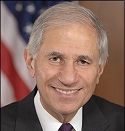By Pam Martens and Russ Martens: May 8, 2024 ~
Yesterday, the Big Law firm Cleary Gottlieb released its so-called “independent review” of charges of sexual harassment at the Federal Deposit Insurance Corporation (FDIC). Although no employee is charging Martin Gruenberg, the Chair of the FDIC, with sexual harassment, Cleary Gottlieb seems to go out of its way to paint Gruenberg in a negative light in the report – 108 times in fact.
Gruenberg held the deciding vote at the FDIC last July when the bank regulator approved moving forward with proposed new rules to significantly raise the capital levels at the megabanks on Wall Street, particularly those holding trillions of dollars in derivatives off their balance sheet. These include the same banks that secretly received $16 trillion in cumulative emergency loans from the Federal Reserve from December 2007 to July 2010 because they were undercapitalized and teetering on insolvency, as well as receiving billions of dollars in equity infusions from the U.S. taxpayer. They also include the same banks that received trillions of dollars in emergency repo loan bailouts in the last quarter of 2019 and more bailouts during the COVID-19 pandemic in 2020.
Those megabanks have now banded together to attempt to stop the FDIC, the Federal Reserve, and the Office of the Comptroller of the Currency (OCC) from giving the final approval to these higher capital rules. No one is fighting harder than Jamie Dimon, Chairman and CEO of JPMorgan Chase.
Knocking Martin Gruenberg out of his post as Chair of the FDIC would assist greatly in giving Wall Street’s Frankenbanks their way on financial reform – once again.
On June 17, 2010, Noam Scheiber, then Senior Editor at The New Republic, explained how Cleary Gottlieb was marshalling the banks together to defeat financial reform, despite their central role in the worst financial collapse in 2008 since the Great Depression. Scheiber wrote:
“While the country was buzzing over the [Obama] inauguration, a group of lobbyists representing its biggest banks assembled in a sleek, wood-paneled conference room at the Washington law firm of Cleary Gottlieb to finalize their counter-strategy on reform…Dimon’s troops had been at the center of the planning for months and helped lead the meeting.
“The main component of the strategy involved derivatives, the financial instrument that allows investors to bet on the price movements of other assets, like stocks and bonds… For the five major U.S. dealers that dominate the market — JP Morgan, Goldman Sachs, Citigroup, Bank of America, and Morgan Stanley — the problem was that derivatives represented billions in annual earnings. They wanted to limit the hit to their bottom line.”
A plan was hatched out of this meeting at Cleary Gottlieb to hire p.r. firms to push the idea that end users of these derivatives – like farmers who use derivatives to hedge cattle prices or a crop failure – would be harmed by the proposed financial reform. In reality – both then and now – the bulk of derivatives trading is for speculation on Wall Street. (For critical background, see Three Wall Street Mega Banks Hold $157.3 Trillion in Derivatives – That’s $56.7 Trillion More than the Entire World’s GDP Last Year and Wall Street CEOs Want the Line Between a Federally-Insured Bank and a Wall Street Trading Casino Erased; Regulators Want Higher Capital to Prevent That.)
Cleary Gottlieb has a lot more recent history with the Wall Street megabanks. The FDIC, the Fed and the OCC released their proposal for higher capital on July 27 of last year. Just one day later, on July 28, Cleary Gottlieb published a detailed critique of the plan which highlighted the opposition against the plan from its clients – the megabanks on Wall Street. The firm wrote:
“Not without opposition. The vote at the FDIC board was 3-2 for publication of the main capital proposal, and the vote at the Federal Reserve Board was 4-2, with strong dissents from some board members echoing recent comments by Congress and trade associations that increasing capital requirements is not currently necessary and is likely to harm the economy and competitiveness of the U.S. banking industry.”
It is correct that some right-wing Republican members of Congress, who receive campaign funding from the megabanks and/or their law firms, are trashing the higher capital proposal in Congressional hearings, sounding very much like bank lobbyists reading from a prepared script.
As recently as February of this year, Cleary Gottlieb represented a consortium of the megabanks — Bank of America, Capital One, JPMorgan Chase Bank, PNC Bank, Truist Bank, U.S. Bank, and Wells Fargo Bank – in regard to their membership interests in the fintech company that owns and operates Zelle. The payment app has come under withering criticism for frauds and scams taking place on Zelle.
Cleary Gottlieb also notes on its website that it has represented the following as financial advisors in various Merger & Acquisition transactions: Bank of America, Citigroup, Goldman Sachs, JPMorgan and Morgan Stanley. These are the five Wall Street megabanks with the largest derivatives exposures.
In what alternative universe from hell can one call Cleary Gottlieb “independent”?


